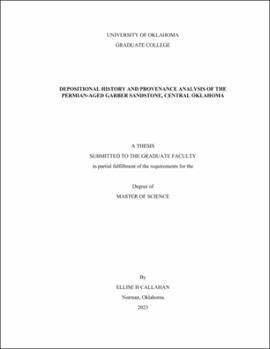| dc.description.abstract | The Lower Permian Kungurian (Leonardian) Garber Sandstone records a time of profound climatic and tectonic transition in central Pangea with the collapse of an icehouse climate, inception of Pangean monsoonal circulation, and the terminations of the Wichita, Ouachita, and Arbuckle regional uplifts. The source, transport direction, and environment of deposition of the Garber Sandstone in central Oklahoma remains poorly understood. Previous interpretations of this unit range from deltaic to fluvial to shallow/marginal marine. Regional studies of Late Paleozoic sediment dispersal are limited for the Early Permian due to lack of outcrops within and particularly east of the Midcontinent. To rectify this information gap, this study utilizes six new U-Pb detrital zircon geochronology analyses from the Garber Sandstone supported by sandstone petrography, paleocurrent data, grain size analysis, and outcrop and core-based facies analyses to assess trends in sediment provenance and depositional processes along strike of an approximately 435 km outcrop belt. Facies from core and outcrop observations show a predominance of cross bedded, massive, and ripple and planar laminated sandstone that likely represent a sandy, ephemeral fluvial system. A continental fluvial system is further supported by analysis of a core in the central outcrop belt that exhibits abundant macroscopic and microscopic pedogenic features. The Garber Sandstone is highly quartzose with minor sedimentary and low-grade metamorphic lithic fragments. Detrital zircon analysis suggests Paleoproterozoic (1800-1600 Ma), Mesoproterozoic (1300-925 Ma), and Neoproterozoic (790-570 Ma) age populations are present and are interpreted to represent Yavapai-Mazatzal, Peri-Gondwanan, Grenville, and Appalachian sources. Further, there is very little difference among the sandstone mineralogy or detrital zircon age spectra across the outcrop belt, suggesting a well-mixed, single source fluvial system.
Ultimately, the Ouachita fold and thrust belt and possibly reworked strata from the Arkoma basin are interpreted as the primary source for the Garber Sandstone based on detrital zircon geochronology and sandstone petrography. This is also supported by limited paleocurrent data that indicate transport directions from the southeast. Notably, zircon grains with 1600-1800 Ma ages prove difficult to constrain and may represent a source from the Sabine block to the southeast or Yavapai-Mazatzal provinces to the west. The results of this study bear importance on paleogeographic interpretations and sediment dispersal trends in Oklahoma with broader implications for the Midcontinent during the Early Permian. This study agrees with more recent paleogeographic interpretations that the Permian seas retreated from Oklahoma by the Kungurian producing an arid continental interior and suggests seasonal drainage from the Ouachita highlands to the southeast. This further implies that the Ouachita fold and thrust belt was likely still a highland even as other studies suggest regional uplifts such as the Wichita uplift were subsiding and buried by this time. | en_US |
